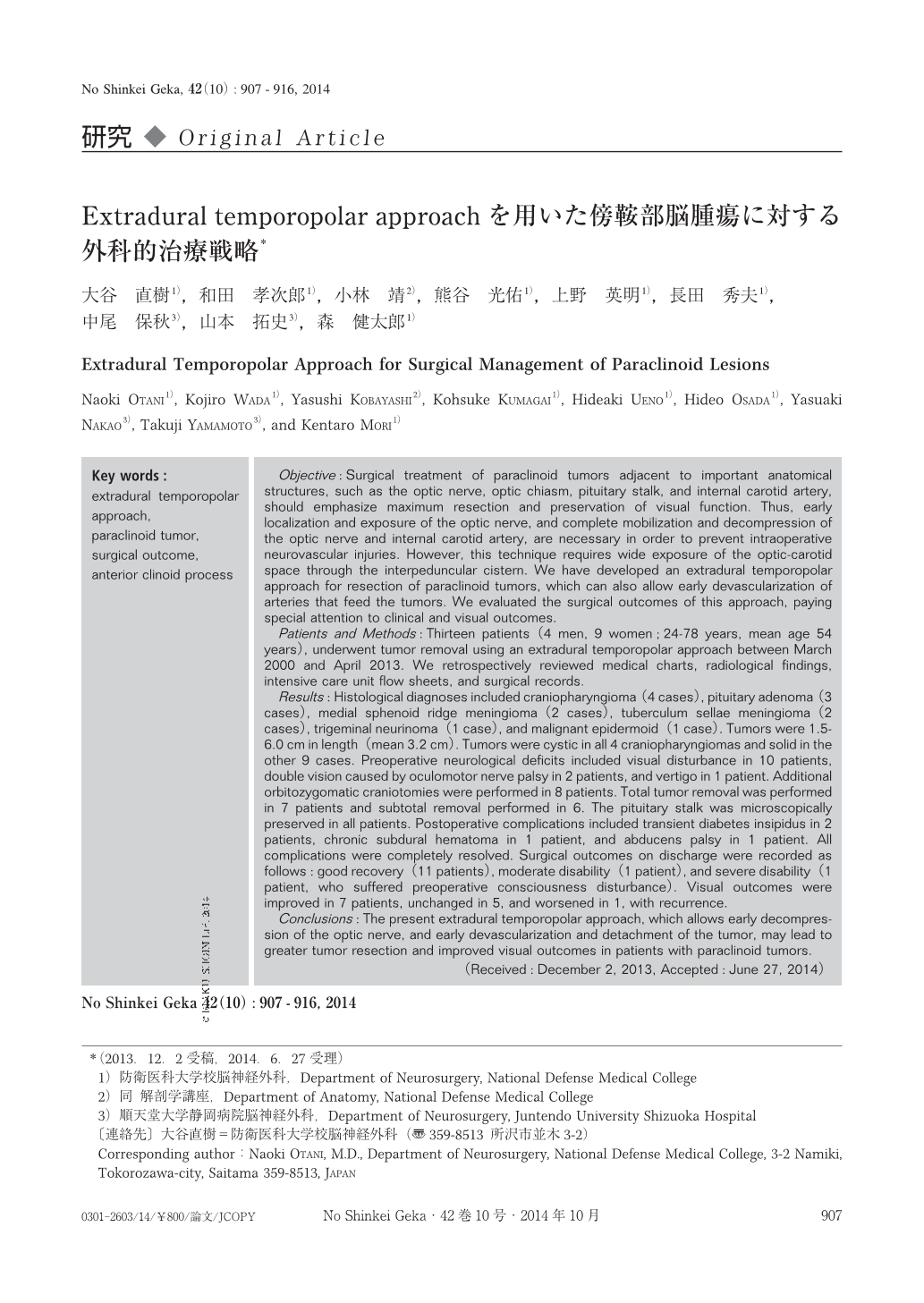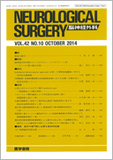Japanese
English
- 有料閲覧
- Abstract 文献概要
- 1ページ目 Look Inside
- 参考文献 Reference
Ⅰ.はじめに
蝶形骨縁内側部から鞍結節部に硬膜付着部をもつ髄膜腫,視神経交叉直下に主座をもつ頭蓋咽頭腫や下垂体腺腫,さらには海綿静脈洞から眼窩先端部に存在する腫瘍などのいわゆる傍鞍部脳腫瘍に対して腫瘍摘出術を施行する際,特に配慮すべき重要な解剖学的構造物には内頚動脈,中大脳動脈,前大脳動脈,視神経,視神経交叉と下垂体茎などがある.傍鞍部脳腫瘍は基本的に良性腫瘍が多いが,腫瘍の再発と再増大には腫瘍摘出率が関連していることから,患者の生命機能予後を最大限に維持しつつ可及的に腫瘍摘出率を向上させることが本病変に対する外科的治療の主眼である.その際,特に視機能に対する機能予後を改善することが重要である.
手術の際には,正確なオリエンテーションの下,早期に視神経の位置を同定し,視神経管を開放し,視神経を減圧しておくことが重要である.このためには前床突起削除が有用である.前床突起を削除し,場合によってはfalciform ligamentやdistal dural ringを切開することで視神経と内頚動脈の可動性を得ることにより,optic-carotid triangle(OCT)の術野面積を広く確保することが可能となる.屍体脳を用いた検討では,OCTの面積は前床突起を削除しない場合に比べて4倍もの術野面積を確保できると報告されている11,22).それにより,視神経交叉直下や脚間槽へアプローチする場合,術野を十分に確保することが可能となり,腫瘍摘出における周辺構造物との剝離の際に,視神経損傷や動脈損傷(特に穿通枝損傷),ひいては下垂体茎や視床下部の損傷を軽減させつつ腫瘍摘出を図ることが可能となる.
前床突起削除法には硬膜内から削除する方法27)と硬膜外から削除する方法4,5,7-10,18,21,29)がある.硬膜外からの前床突起削除法は,Dolenc7)が世界に先がけて報告し,脳底動脈瘤の処理や,下垂体病変の摘出にも応用されている8-10).Yonekawaら29)は鞍上部・傍鞍部腫瘍に対して選択的硬膜外前床突起削除法の有用性を報告しており,前床突起髄膜腫18),鞍結節部髄膜腫25)などの摘出において視機能温存と腫瘍摘出率の向上に有用であったと報告している.一方,DayらはDolenc法の変法として側頭葉固有硬膜を海綿静脈洞外側壁から剝離することによって前床突起を硬膜外に露出した後に削除し,さらに小脳テントを切開して側頭葉を硬膜ごと後方に移動することによって,開放された海綿静脈洞越しに内頚動脈後方から脚間槽にまでアプローチする方法をextradural temporopolar approach(EDTPA)として報告している4,5).今回われわれは,傍鞍部腫瘍に対するEDTPAによる前床突起削除法を用いた腫瘍摘出術の実際と治療成績を提示し,その有用性について文献的考察を加えて検討する.
Objective:Surgical treatment of paraclinoid tumors adjacent to important anatomical structures, such as the optic nerve, optic chiasm, pituitary stalk, and internal carotid artery, should emphasize maximum resection and preservation of visual function. Thus, early localization and exposure of the optic nerve, and complete mobilization and decompression of the optic nerve and internal carotid artery, are necessary in order to prevent intraoperative neurovascular injuries. However, this technique requires wide exposure of the optic-carotid space through the interpeduncular cistern. We have developed an extradural temporopolar approach for resection of paraclinoid tumors, which can also allow early devascularization of arteries that feed the tumors. We evaluated the surgical outcomes of this approach, paying special attention to clinical and visual outcomes.
Patients and Methods:Thirteen patients(4 men, 9 women;24-78 years, mean age 54 years), underwent tumor removal using an extradural temporopolar approach between March 2000 and April 2013. We retrospectively reviewed medical charts, radiological findings, intensive care unit flow sheets, and surgical records.
Results:Histological diagnoses included craniopharyngioma(4 cases), pituitary adenoma(3 cases), medial sphenoid ridge meningioma(2 cases), tuberculum sellae meningioma(2 cases), trigeminal neurinoma(1 case), and malignant epidermoid(1 case). Tumors were 1.5-6.0cm in length(mean 3.2cm). Tumors were cystic in all 4 craniopharyngiomas and solid in the other 9 cases. Preoperative neurological deficits included visual disturbance in 10 patients, double vision caused by oculomotor nerve palsy in 2 patients, and vertigo in 1 patient. Additional orbitozygomatic craniotomies were performed in 8 patients. Total tumor removal was performed in 7 patients and subtotal removal performed in 6. The pituitary stalk was microscopically preserved in all patients. Postoperative complications included transient diabetes insipidus in 2 patients, chronic subdural hematoma in 1 patient, and abducens palsy in 1 patient. All complications were completely resolved. Surgical outcomes on discharge were recorded as follows:good recovery(11 patients), moderate disability(1 patient), and severe disability(1 patient, who suffered preoperative consciousness disturbance). Visual outcomes were improved in 7 patients, unchanged in 5, and worsened in 1, with recurrence.
Conclusions:The present extradural temporopolar approach, which allows early decompression of the optic nerve, and early devascularization and detachment of the tumor, may lead to greater tumor resection and improved visual outcomes in patients with paraclinoid tumors.

Copyright © 2014, Igaku-Shoin Ltd. All rights reserved.


